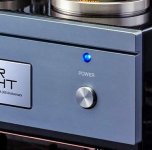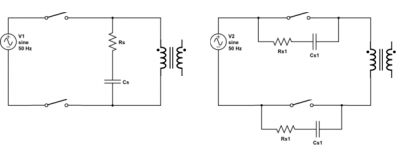For the amp I'm building I'm looking for a mains switch and despite going through similarly named threads, I can't really find an answer to my question. That is, how do I calculate the minimum safe amp rating for the switch? Or at least, what is a good rule of thumb?
The amp should pull no more then 100W @230V so that would mean 0.43A but that doesn't seem right.
I'm looking for a switch like in the attached picture but the only ones I can find are 3 amp rated or close to that and from what I read, that's (too) low.
The amp in the image is similar to what I'm building (300B SE stereo) so I know it should be possible.
Thanks
The amp should pull no more then 100W @230V so that would mean 0.43A but that doesn't seem right.
I'm looking for a switch like in the attached picture but the only ones I can find are 3 amp rated or close to that and from what I read, that's (too) low.
The amp in the image is similar to what I'm building (300B SE stereo) so I know it should be possible.
Thanks
Attachments
Last edited:
3A rating at 250v will cover most equipment up to 630W, slightly more if you snubber the contact to help with contact arcing. You could of course use a small neat switch and a 230v coil relay. Simple and the sky is the limit.
I would say 3A is sufficient though, especially if you use an NTC to feed the load, if very heavy.
I would say 3A is sufficient though, especially if you use an NTC to feed the load, if very heavy.
Jon, I'm reading that the inductive load of a power supply has an inrush current that greatly exceeds the normal operating current, 8 to 10 times as much.
For my own education, am I correct in thinking that this is a basis for a good rule of thumb for selecting the switch amperage?
For my own education, am I correct in thinking that this is a basis for a good rule of thumb for selecting the switch amperage?
All loads spike when switched. The switch maker knows this all too well, and allows for some abuse.
Read the switch maker's guidelines. Here's one:
https://www.nkkswitches.com/pdf/electricalratings.pdf
Your amplifier is nominal 230V 0.43 Amps.
You find a switch rated say 120V 3A.
NKK's guideline for re-rating for 250V and capacitive ("..such loads as DC power supplies") load is 0.12 to 0.16, say 0.125. (This happens to echo Galu's "8..".) The 120V 3A switch is good for 0.375A nominal steady load.
This is very close to your hoped-for 0.43A. If I found a just-right style at a good price, I'd just buy several. Maybe the first one really lasts forever (10,000 cycles is a very long time for a hi-fi, maybe decades). Maybe the surge hits the switch wrong and two die in a year; then pick a different style. (Use the small switch to work a relay?)
Read the switch maker's guidelines. Here's one:
https://www.nkkswitches.com/pdf/electricalratings.pdf
Your amplifier is nominal 230V 0.43 Amps.
You find a switch rated say 120V 3A.
NKK's guideline for re-rating for 250V and capacitive ("..such loads as DC power supplies") load is 0.12 to 0.16, say 0.125. (This happens to echo Galu's "8..".) The 120V 3A switch is good for 0.375A nominal steady load.
This is very close to your hoped-for 0.43A. If I found a just-right style at a good price, I'd just buy several. Maybe the first one really lasts forever (10,000 cycles is a very long time for a hi-fi, maybe decades). Maybe the surge hits the switch wrong and two die in a year; then pick a different style. (Use the small switch to work a relay?)
Great info, exactly what I was looking for. Thank you all.
I was already thinking about adding some kind of snubber/inrush current limiter.
I was wondering about putting a (R)C across the contacts of the switch. Doesn't that put the mains in direct contact with the circuitry and also, the cap will always be charged so touching the pin of the mains lead-in will shock you, if only a tiny bit?
I was already thinking about adding some kind of snubber/inrush current limiter.
I was wondering about putting a (R)C across the contacts of the switch. Doesn't that put the mains in direct contact with the circuitry and also, the cap will always be charged so touching the pin of the mains lead-in will shock you, if only a tiny bit?
People used to put .01 uf 1000 vdc across the contacts of the AC switch to silence the turn-off pop of an amplifier or TV, but those caps have been deemed non-suitable for mains AC use. I did have a lightning surge on the AC line vaporize one in 1982. PAS2 had a thick metal case so any shrapnal was not external. Now you have to use X or Y rated capacitors on AC mains. Also a little tingle from the case wasn't a design defect in 1954. So don't do it.
I mounted the CL101 thermistor in my PV-1.3k amplifier on a cinch solder terminal strip, in between the spade lug coming in from the AC cord and the AC power board lead. That amp used to dim the lights in the room when I turned it on, and used a triac instead of a power switch to power the transformer. The actual power switch controlled the gate current to the triac. CL-101 is too low resistance for your little device; use one like the one I suggested. There are other brands NTC thermistor now than GE.
I mounted the CL101 thermistor in my PV-1.3k amplifier on a cinch solder terminal strip, in between the spade lug coming in from the AC cord and the AC power board lead. That amp used to dim the lights in the room when I turned it on, and used a triac instead of a power switch to power the transformer. The actual power switch controlled the gate current to the triac. CL-101 is too low resistance for your little device; use one like the one I suggested. There are other brands NTC thermistor now than GE.
Last edited:
> A thermistor like a GE CL-120 .... Cold resistance 10 ohm
10 Ohms at 230V is 23 Amps.
It is likely he already has 20-30 Ohms of transformer and rectifier impedance. 10 more Ohms makes a small change. Like from 10A to 7A. Rated 1.7A is a bit big for a 0.43A load. You need that thermistor to get hot so its resistance goes down.
You would normally pick a thermistor "close" to the expected running current.
But really. Switches and switch-abuse are old news to switch makers. The nominal 0.43A is well under the rated 3A steady load the switch is good for. The cap-input derating is in-sight of the load. The life-rating of most switches is more than most hi-fi will ever see.
10 Ohms at 230V is 23 Amps.
It is likely he already has 20-30 Ohms of transformer and rectifier impedance. 10 more Ohms makes a small change. Like from 10A to 7A. Rated 1.7A is a bit big for a 0.43A load. You need that thermistor to get hot so its resistance goes down.
You would normally pick a thermistor "close" to the expected running current.
But really. Switches and switch-abuse are old news to switch makers. The nominal 0.43A is well under the rated 3A steady load the switch is good for. The cap-input derating is in-sight of the load. The life-rating of most switches is more than most hi-fi will ever see.
Also a little tingle from the case wasn't a design defect in 1954
I'm sure my cat would disagree though
> only on the contacts switching the hot wire?
Which wire is hot?
Isn't that why you use a 2-pole switch? In many lands you can't be sure because the wall-plug can be inserted both ways. In the US we have a fat-blade convention but 60% of the outlets in my last kitchen were wired H/N reverse.
Do both poles.
Which wire is hot?
Isn't that why you use a 2-pole switch? In many lands you can't be sure because the wall-plug can be inserted both ways. In the US we have a fat-blade convention but 60% of the outlets in my last kitchen were wired H/N reverse.
Do both poles.
any switch which lacks a spring mechanism is doomed to failed:
the operator can slowly turn it on with caution which enabled the arc situation to last long enough to destroy it...
A good switch is not only an Amp rating, it is a good latch mechanism preventing user error and arcing. Most modern use relay contacts because they are activated fast by a transistor. the user only controls the transistors which substitute the spring... complicated explanation but very simple facts.
Any big 50 amp switch can be destroyed if you just slightly press it to the arcing point and hold it there to burn. A small 2 amp switch which is very fast all the time is going to last longer.
the operator can slowly turn it on with caution which enabled the arc situation to last long enough to destroy it...
A good switch is not only an Amp rating, it is a good latch mechanism preventing user error and arcing. Most modern use relay contacts because they are activated fast by a transistor. the user only controls the transistors which substitute the spring... complicated explanation but very simple facts.
Any big 50 amp switch can be destroyed if you just slightly press it to the arcing point and hold it there to burn. A small 2 amp switch which is very fast all the time is going to last longer.
I would just use a 13 amp 240VAC rated mains switch.
They are pretty common.
I used to run a mobile disco that had two record decks controlled by mains switches.
When I turned them on I got a huge pop through speakers.
I found a 100nf X2 capacitor across the switch sorted that out.
They are pretty common.
I used to run a mobile disco that had two record decks controlled by mains switches.
When I turned them on I got a huge pop through speakers.
I found a 100nf X2 capacitor across the switch sorted that out.
Put the snubber across the mains transformer primary. It will snub whichever switch contact happens to break first; the other contact does not need snubbing. It will also mean longer life for the snubber capacitor, and 'off' really means off.
If for some reason you want to put a snubber on the switch then you need to do it for both contacts because you don't know which will break first.
If for some reason you want to put a snubber on the switch then you need to do it for both contacts because you don't know which will break first.
- Status
- This old topic is closed. If you want to reopen this topic, contact a moderator using the "Report Post" button.
- Home
- Amplifiers
- Power Supplies
- Mains, on-off switch rating

